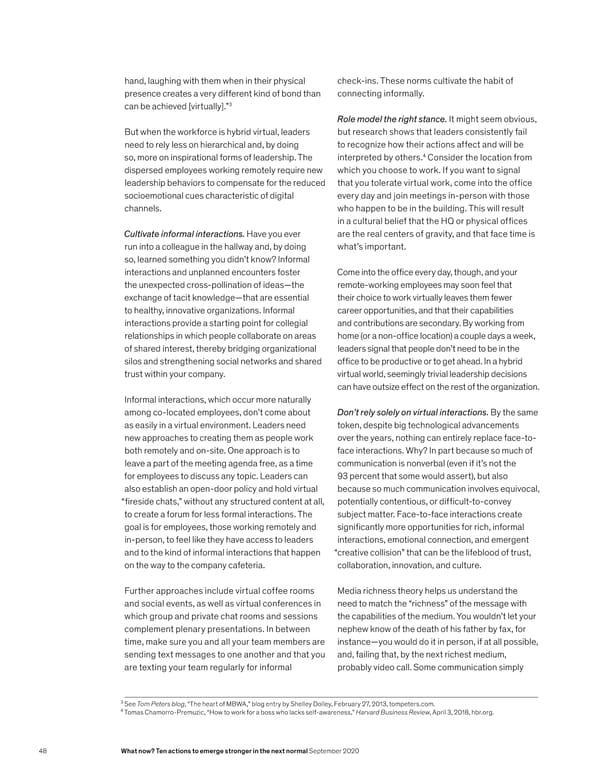hand, laughing with them when in their physical check-ins. These norms cultivate the habit of presence creates a very different kind of bond than connecting informally. can be achieved [virtually].”3 Role model the right stance. It might seem obvious, But when the workforce is hybrid virtual, leaders but research shows that leaders consistently fail need to rely less on hierarchical and, by doing to recognize how their actions affect and will be so, more on inspirational forms of leadership. The interpreted by others.4 Consider the location from dispersed employees working remotely require new which you choose to work. If you want to signal leadership behaviors to compensate for the reduced that you tolerate virtual work, come into the office socioemotional cues characteristic of digital every day and join meetings in-person with those channels. who happen to be in the building. This will result in a cultural belief that the HQ or physical offices Cultivate informal interactions. Have you ever are the real centers of gravity, and that face time is run into a colleague in the hallway and, by doing what’s important. so, learned something you didn’t know? Informal interactions and unplanned encounters foster Come into the office every day, though, and your the unexpected cross-pollination of ideas—the remote-working employees may soon feel that exchange of tacit knowledge—that are essential their choice to work virtually leaves them fewer to healthy, innovative organizations. Informal career opportunities, and that their capabilities interactions provide a starting point for collegial and contributions are secondary. By working from relationships in which people collaborate on areas home (or a non-office location) a couple days a week, of shared interest, thereby bridging organizational leaders signal that people don’t need to be in the silos and strengthening social networks and shared office to be productive or to get ahead. In a hybrid trust within your company. virtual world, seemingly trivial leadership decisions can have outsize effect on the rest of the organization. Informal interactions, which occur more naturally among co-located employees, don’t come about Don’t rely solely on virtual interactions. By the same as easily in a virtual environment. Leaders need token, despite big technological advancements new approaches to creating them as people work over the years, nothing can entirely replace face-to- both remotely and on-site. One approach is to face interactions. Why? In part because so much of leave a part of the meeting agenda free, as a time communication is nonverbal (even if it’s not the for employees to discuss any topic. Leaders can 93 percent that some would assert), but also also establish an open-door policy and hold virtual because so much communication involves equivocal, “fireside chats,” without any structured content at all, potentially contentious, or difficult-to-convey to create a forum for less formal interactions. The subject matter. Face-to-face interactions create goal is for employees, those working remotely and significantly more opportunities for rich, informal in-person, to feel like they have access to leaders interactions, emotional connection, and emergent and to the kind of informal interactions that happen “creative collision” that can be the lifeblood of trust, on the way to the company cafeteria. collaboration, innovation, and culture. Further approaches include virtual coffee rooms Media richness theory helps us understand the and social events, as well as virtual conferences in need to match the “richness” of the message with which group and private chat rooms and sessions the capabilities of the medium. You wouldn’t let your complement plenary presentations. In between nephew know of the death of his father by fax, for time, make sure you and all your team members are instance—you would do it in person, if at all possible, sending text messages to one another and that you and, failing that, by the next richest medium, are texting your team regularly for informal probably video call. Some communication simply 3 See Tom Peters blog, “The heart of MBWA,” blog entry by Shelley Dolley, February 27, 2013, tompeters.com. 4 Tomas Chamorro-Premuzic, “How to work for a boss who lacks self-awareness,” Harvard Business Review, April 3, 2018, hbr.org. 48 What now? Ten actions to emerge stronger in the next normal September 2020
 What Now? Page 49 Page 51
What Now? Page 49 Page 51